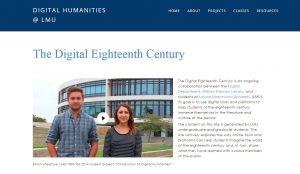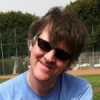In fall 2014, Dermot Ryan—an associate professor in the Department of English at Loyola Marymount University—and Melanie Hubbard—the university’s digital scholarship librarian—designed and taught The Digital Eighteenth Century, a class which culminated in the creation of a digital space that showcases the digital projects students completed over the course of the semester. You can find a video introduction to our class and the various student digital projects at dh@lmu.
Our concept for the class was simple: students would better grasp the literature and culture of the eighteenth century by drawing connections between the eighteenth-century print revolution and aspects of the current digital communications revolution. The incorporation of digital tools and assignments was intended to illustrate and provide hands-on experience with this technological shift as well as give students a new way into the study and presentation of eighteenth-century cultural materials.
The assignments were fairly basic. Students used the Eighteenth Century Collections Online (ECCO) database not simply to locate specific texts but rather to answer basic research questions. How many titles containing the adjective “lyrical” appear before the 1798 publication of Lyrical Ballads? Can we trace any other literature on children chimney sweepers before William Blake’s poem on the subject? Can we locate sources for the figure of the hermit in Charlotte Smith’s poem Beachy Head? Students used TimeMapper to track the development of eighteenth-century literary or cultural events across space as well as time (see example). Poetry Genius, an online annotation tool, was used to become more familiar with eighteenth-century poetry (see example). Students brought eighteenth-century visual and literary culture together by creating digital essays in Tumblr (see example). Because their work would be public, students were required to keep their audience in mind and ask themselves the following types of questions: What helps me understand the literature and cultural artifacts that we are studying in this class? How do I present these materials in a manner that a broader audience would find accessible and compelling?
The students’ projects are now part of dh@lmu, a site that Melanie created to be a hub for LMU’s current and future DH projects. In a sense, The Digital Eighteenth Century was our practical response to a series of interrelated challenges that many of our colleagues face: How do you foster digital humanities at a university that is largely focused on undergraduate education and has many of the trademarks of a liberal arts college? How do you get from zero with little or no resources and a minimum of institutional support? How do you do that when you yourself have had little or no institutional exposure to professional training in the tools, practices, and methods of DH?
We discussed our experience of designing and teaching this course at the 2014 Digital Scholarship Colloquium organized by the Freedman Center for Digital Scholarship at Case Western Reserve University’s Kelvin Smith Library. Our presentation entitled “The Promise of Digital (Undergraduate) Research: A Perspective from a Liberal Arts College” is available for viewing. In this presentation we explain that our discussions about DH began with our desire to engage more humanities students in undergraduate research (UR). We speculated that DH could help us overcome some of the difficulties with sustaining UR culture in the humanities. Such difficulties include:
- Research in the humanities tends to be non-collaborative.
- UR in the humanities has traditionally involved student-led initiatives with students working on topics related only tangentially to a faculty member’s own research.
- Research in the humanities cannot be easily “segmented” into manageable units for undergraduate researchers.
- There is a high threshold to entry into humanities research.
- There is no incentive: in universities that do not have large Ph.D. or postdoctoral programs, the sciences “need” undergraduates to conduct research; conversely, UR potentially distracts humanist scholars from their research.
Ways in which we feel DH can potentially address these challenges include:
- DH can challenge the canard that research in the humanities is inherently non-collaborative.
- Research projects in DH can be parsed into manageable units.
- DH can allow us to generate online research projects that allow for ongoing student/faculty collaboration while contributing to faculty scholarship, rather than diverting attention from faculty research.
The eighteenth century is a particularly rich time period for these kinds of faculty and student collaborations not only because eighteenth-century print culture with its focus on social networking and media storms bears some striking resemblances to our particular moment but also because there are a number of rich online eighteenth-century resources, like ECCO, on which our students can draw.


